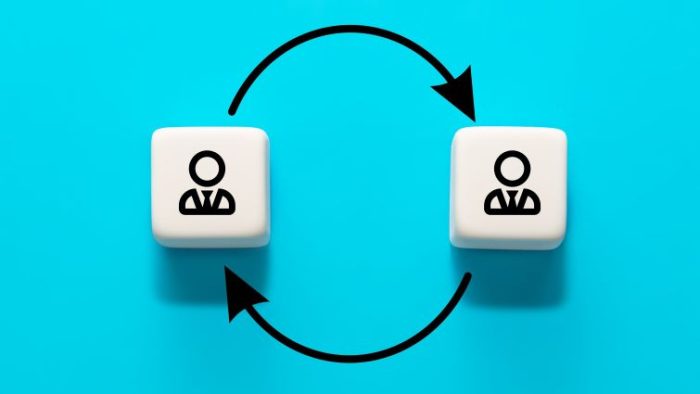How to Make the Switch from Being an Employee to Entrepreneur
 Publié le 9 January 2024
Publié le 9 January 2024
Take charge of your career by knowing how to make the switch from being an employee to entrepreneur.
When you look at the most successful and innovative entrepreneurs today, it’s essential to remember that most didn’t start as high-flying business owners. Instead, many of them will have begun in a similar position to you: an employee who’s just trying to pay the bills, dreaming of a bigger future.
However, transitioning from employee to entrepreneur isn’t as easy as it initially sounds.
Moving out of the long-term security of a job into the uncertain waters of entrepreneurship carries many risks. Becoming an entrepreneur can sometimes be an emotional and mental challenge – after all, reports show that most startups will fail.
But that doesn’t mean it’s not a risk worth taking. There are also numerous benefits to starting your own business and being your own boss. And it could be a wonderful opportunity to follow your passion.
Ultimately, it’s about carefully planning the transition so you set yourself and your business up to succeed. So, if you’re ready to swap hats and take up the title of entrepreneur, read on to discover our tips for setting up a business while in a full-time job.
Free to use image sourced from Unsplash
Where to start
Changing jobs or careers is a substantial decision – moving into the unknown by becoming an entrepreneur is even more of a leap. So, before investing time or money into your business project, you need to ask yourself a few pertinent questions and find time to develop skills that will help you thrive.
Use the below checklist during this phase of the transition from employee to entrepreneur.
Figure out if now is the right time
This might not be what you want to hear. After all, aspiring entrepreneurs are usually convinced that they’ve got an idea that needs to be shared with the world as soon as possible. However, you need to be sure that this is the right time to make the switch.
Consider why you want to leave your job and become a full-time entrepreneur. Are you frustrated with something recent at work? Or have you been thinking about this for a long time?
Similarly, you might want to consider whether you have the right level of professional maturity and experience to strike out on your own. If you’ve only been working for a year or two, you might find that you can gain more in your personal development by staying in your current organization. Doing so leaves you better placed to succeed as an entrepreneur in a few years.
Reflect on your strengths and weaknesses
If you decide that now is the right time for you to switch from employee to entrepreneur, remember that you’ll essentially be becoming your own boss. And just as any good boss knows the strengths and weaknesses of their employees, you’ll need to have a solid understanding of your areas of confidence and where you need to improve.
Fortunately, no one knows you better than you, so you should be able to recognize your strengths and flaws and build your plan around that. You’ll use this information to develop yourself and your skills before leaving full-time employment.
Identifying your strengths and weaknesses also acts as a final safeguard against bad decision-making as you set out on your entrepreneurship. If you recognize that you’re a poor communicator, for example, you might choose to find a business partner who can support you in this area.
Reflecting on areas for improvement also allows you to develop the personal and professional qualities that will help you as a business owner. Consider upskilling in your weak areas as well as a range of areas that are specific to business, leadership, and your industry.
For example, if you’re setting up a customer-facing business, you might want to work on your technical knowledge by training in hosted contact centre solutions. Or you might hone your public speaking or leadership skills knowing you’ll have to pitch your business plan to potential investors.
Of course, making this sort of personal progress can be difficult when you also have to balance life as a full-time employee. However, working on yourself for an hour or so after work can pay off significantly in the long term.
Set up targets
Free to use image sourced from Unsplash
When you know you’re ready to switch to from being an employee to entrepreneur, it’s time to think about how you make that a reality. To achieve this, set up realistic targets that fit alongside an ideal future timeline.
You could start small – maybe just researching another company’s CSAT survey to learn more about your industry and competitors by the end of the month. From here, you can build up to the opening of your business and the beginning of your life as an entrepreneur.
By building small targets and goals, you’ll be able to work on your knowledge and skills to perfectly place yourself in a position to succeed as an entrepreneur.
Establishing a business
Working on your personal qualities is all about ensuring you’re well-prepared to succeed as an entrepreneur. However, before you leave your steady job behind and dive headfirst into the world of entrepreneurship, you’ll have to actually work on your business.
Here are the main things that you need to get your start-up off the ground.
Nail your business idea
Potential entrepreneurs will often have many different business ideas buzzing around their heads at any one time. Although this is a great source of creative inspiration, if you want to practically succeed as an entrepreneur, you must nail down one specific business idea.
Free to use image sourced from Unsplash
Think about the concept that best suits your personal qualities and work experience. Then decide whether this can be profitable and scalable. Only then are you ready to put time and money into becoming an entrepreneur. Start by putting these ideas into a clear and persuasive business plan.
If you really want to impress potential investors and be confident that your plans are watertight, make them as detailed as possible. A typical business plan includes:
- Executive summary
- Company description
- Market analysis
- Company structure
- Product or service line
- Marketing and sales strategy
- Financial projections
You might also choose to include any specific requests for funding and an appendix with supporting documents specific to your business, such as licenses, patents, or legal documents. Don’t forget to add technical details, such as the cost of software for improving productivity or whether you’ll follow a unified data model to keep company and client data secure.
Start networking
Free to use image sourced from Unsplash
Networking with other entrepreneurs and professionals enables you to build relationships with mentors, experienced business people, and investors. You can even do this as part of your current full-time position.
Look out for local networking meetings that you can attend, and use every opportunity in your current role to meet new professionals and build your networking skills.
But these don’t have to be in-person events. You can also leverage social media platforms to connect with like-minded individuals and expand your network further.
Sort your financing
When you become a full-time entrepreneur, your head will be swimming with different financial and regulatory demands, from figuring out the difference between an exempt vs non exempt employee to making sure your taxes are in order.
It can be useful to sort out your financing before transitioning out of employment. Consider your expected costs and weigh up whether or not you have adequate funding already. If not, start looking for financing. Research shows that 31% of startups need under $10,000 in capital, so sourcing this isn’t out of reach.
3 steps to transition from employee to entrepreneur
Now that you’ve built the foundations, it’s time to make the switch to being a full-time entrepreneur. Here are our three key tips to help you transition.
1. Respect your employer
When you’re actively transitioning out of your current job – and you’ve handed in your notice – it’s important that you remain committed to your employer. Try not to spend too much time working on your business and don’t let your ambitions affect your performance at work.
This isn’t just about being respectful; not putting in the time and effort at work will leave a bad impression that could impact your future prospects, especially if you’re starting a business in a related field.
2. Grow gradually
Free to use image sourced from Unsplash
Setting up a business is all about dreaming big. However, you must build your organization gradually. Start small and then worry about how you can scale up once demand increases.
With 5 million new businesses created in the US in 2022 alone, you need to be realistic and recognize that not all will be an instant success.
3. Outsource and recruit others
While it’s important that you manage expectations in the early stages of a startup, you should still prepare for the process of scaling up. As your business grows, you won’t have time to manage everything – rather than Googling ‘what is VoIP’, for instance, you might choose to recruit a tech specialist.
Similarly, you’ll find that outsourcing certain business processes will provide a stronger return on investment than managing them in-house. A big part of making the transition from employee to entrepreneur is knowing when to make these decisions.
Ready to take the leap?
Making the switch from employee to entrepreneur can be daunting. You’re stepping into the unknown, so it’s a big leap of faith.
Before you start the transition, it’s important that you’re realistic about your strengths and weaknesses and develop yourself so that you’re well-placed to succeed as an entrepreneur.
Use this article as a guide before you even start the process of establishing your business. Be proactive now by starting to network, cementing a business idea, and figuring out financing. By getting ahead, you can be confident that you’re making the right decision as you become a full-time entrepreneur.







